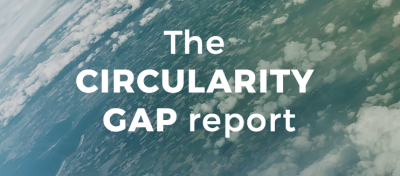Only nine percent of the world economy is ‘circular’, claims Global Circularity Report
With the release of social enterprise Circle Economy’s Global Circularity Report on Tuesday (23 January), which claims that only nine per cent of the world’s resources are cycled back into the economy after use, the circular economy is high on the agenda at this year’s World Economic Forum (WEF) Annual Meeting.
The WEF is an independent global organisation focused on driving international cooperation to address the economic, political and social challenges of the age. Its Annual Meeting, held in Davos, Switzerland, from 23-26 January brings together world leaders in politics, business, the non profit sector and beyond to define an agenda for change under the theme ‘Creating a Shared Future in a Fractured World’.
Released on the first day of the WEF, the headline-grabbing Global Circularity Report defines what it calls a global ‘circularity gap’ between the resources we use and the amount that is reused, claiming that the world is ‘only 9.1 per cent circular’: more than 90 per cent of the raw materials used globally do not find their way back into the economy.
The report uses the Global Circularity Metric to measure the yearly state of the world’s economy in terms of what resources we use and what we cycle back into the economy, while referencing UN environment statistics that demonstrate that a circular economy would bring environmental benefits in the form of a 28 per cent reduction in global resource use and a cut in greenhouse gas emissions of 72 per cent.
The Report looks at six key societal needs and consumables that us the most materials globally - housing and infrastructure, nutrition, mobility, consumables, services, healthcare and communication - and identifies where materials leakages occur most frequently.
Circle Economy recommends four steps aimed at bridging the circularity gap through committed leadership and action:
- Build a global coalition for action;
- Develop a global target and action agenda;
- Translate global targets to local action roadmaps; and
- Improve our understanding of circular systems.
Commenting on the release of the report, Harald Friedl, Chief Executive of Circle Economy and co-author of the report, said: “Today’s take-make-waste economic model is not fit for purpose. Embedded in this tradition of the linear economy lies a toxic cocktail or negative consequences, ranging from social inequality to depletion of natural resources, environmental pollution and worsening of the risks and effects of climate change.”
He continued: “We call upon businesses and governments to take leadership to develop an action agenda and contribute to the global targets set in the SDGs and the Paris Agreement.” Claiming that a fully circular global economy would cut greenhouse gas emissions and resource use by 72 and 28 per cent respectively, the report calls for the adoption of a Global Circularity Metric to close the circularity gap by setting global targets and tracking performance year-on-year.
Mainstreaming the circle
That circularity has been a much-discussed subject so far at the WEF reflects a fast-growing global mainstreaming of the concept into economic discourse, particularly in relation to plastic waste, which has become a rallying point for campaigners and the public.
Earlier this month (16 January), a landmark plastics strategy was launched as part of the EU’s Circular Economy Package, a set of laws and actions for a more resource-efficient Europe. The strategy focuses on developing secondary markets for recycled plastics in order to combat the growing plastic pollution problem, while the wider package of laws will set an EU-wide recycling target of 60 per cent by 2030.
Circular economy champion Dame Ellen MacArthur, founder of the Ellen MacArthur Foundation (EMF), also chose Davos as the place to announce the winners of the $1 million Circular Materials Challenge, which rewards five businesses creating environmentally-friendly alternatives to plastic packaging.
The challenge is part of the EMF’s New Plastics Economy initiative, which builds on the concepts in a 2016 report of the same name, calling for systemic change across the global plastics chain to create ‘an effective after-use plastics economy’. MacArthur has also placed the circular economy front and centre in the fashion industry, with a report in November 2017 titled ‘A new textiles economy’.
The WEF also saw 11 companies, including Coca-Cola, Unilever, L’Oreal, Pepsico and Evian, reaffirm or announce pledges to achieve a ‘100 per cent circular approach to plastic use’ by 2025, using only reusable, recyclable or compostable packaging. The 11 companies produce more than 6 million tonnes of plastic packaging per year, andd similar promises to address the packaging waste problem are coming thick and fast from producers, retailers and reprocessors across the globe.
Commenting on the announcement, Paul Polman, CEO of Unilever, said: “It is welcome news that many other major companies are making their own commitments to address ocean plastic waste. Yet as a consumer good industry, we need to go much further, much faster, in addressing the challenge of single-use plastics, by leading a transition away from the linear take-make-dispose model of consumption, to one which is truly circular by design.”







